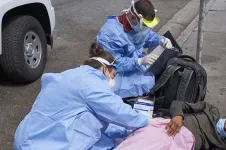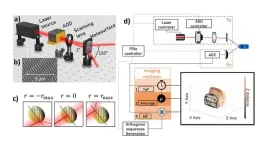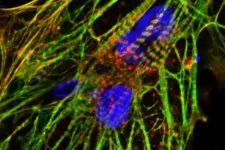(Press-News.org) A newly described type of chemistry in fungi is both surprisingly common and likely to involve highly reactive enzymes, two traits that make the genes involved useful signposts pointing to a potential treasure trove of biological compounds with medical and chemical applications.
It was also nearly invisible to scientists until now.
In the last 15 years, the hunt for molecules from living organisms — many with promise as drugs, antimicrobial agents, chemical catalysts and even food additives — has relied on computer algorithms trained to search the DNA of bacteria, fungi and plants for genes that produce enzymes known to drive biological processes that result in interesting compounds.
“The field kind of hit a wall in the early 2000s, when the discovery process was to extract things from fungi and see what those extracts did. But we kept rediscovering the same things,” says Grant Nickles, a graduate student in the lab of Nancy Keller, professor of medical Microbiology and immunology. “As we learned more about the genes that make these cool natural products, we designed algorithms that could search for them, find targets and make the process much more efficient.”
That method also hit a wall of sorts because the algorithms only had eyes for certain types of genes.
“The main algorithms made to find natural products work great, but they are focused on genes related to three canonical backbone enzymes,” says Keller. “There have been incremental improvements to those algorithms, but you can only search the same genomes for similar genes so many times before you are, again, rediscovering the same things.”
In 2005, a community of researchers sequenced the genome of Aspergillus fumigatus, a fungus that can infect people with compromised immune systems.
“The first sequence made the hairs on my arms rise,” Keller says. “There were so many clusters of genes of the type that make these backbone enzymes that produce interesting secondary metabolites. I said, ‘Oh! There’s a lot more natural products in fungi than we ever could have guessed.’”
In subsequent research, Keller’s lab uncovered at least one cluster of genes involved in biochemical processes reliant on a backbone enzyme called isocyanide synthase, which is not one of the three “canonical” enzymes known to be common chemical workhorses across bacteria and fungi.
This month, Nickles, Keller and collaborators published a new study in the journal Nucleic Acids Research in which they describe a new algorithm they created to search fungal genomes for the groups of genes, called biosynthetic gene clusters, that synthesize isocyanide to do their work.
“I ran the new algorithm on every fungal genome that I could find on the internet — about 3,300 species — and found that that this is the fifth-largest class of natural products produce by fungi,” Nickles says. “And it was almost completely invisible prior to this study.”
More than 1,300 fungal species have clusters of genes centered on isocyanide chemistry.
“It’s so likely these gene clusters are producing something useful to the fungus, or it would be hard to explain why these genes are so common and preserved across the genomes of so many species,” says Milton Drott, co-author of the new study and a former member of Keller’s lab now working as a plant pathologist at the U.S. Department of Agriculture’s Cereal Disease Lab. “What we’ve made is an atlas of those gene clusters. You can start to see interesting patterns there that point to where to look first for significant functions.”
Highest on Keller’s list will be clusters in which the surrounding genes are ones known to tailor enzymes for different purposes or transport them to specific locations or “promoter” genes that flip the switch — on or off — for enzyme production based on conditions in their cells.
“We're looking for uniqueness,” says Keller, whose work is supported by the National Institutes of Health and who is co-founder of a company, Terra Bioforge, that makes useful natural products discovered in microbes. “Unique combinations of member genes in a cluster may tell us something about the activity of the structure. But my expectation is that we won’t be the only ones looking.”
The researchers catalogued their fungal findings on a searchable website created by co-author Brandon Oestereicher, meaning many other labs won’t even have to run an algorithmic search — a resource-heavy process that required the help of UW–Madison’s High Throughput Computing Center.
“Labs with a favorite species of fungus — that’s not unusual for people in our field, that they are focused on a species or a narrow range of species — can look their species up on the website and get enough information on the gene clusters to start their own work on isocyanides,” says Drott.
That research may reveal natural compounds with great benefits to society — antibacterial drugs, pesticides, new catalysts for industrial and pharmaceutical chemistry — but the products and purposes of this new biological chemistry are still largely unknown. Drott’s lab studies members of the fungal genus Fusarium that cause blight in grains like barley and wheat. They also have isocyanide biosynthetic gene clusters.
“This is exciting for our work, because these gene clusters may play a role in that pathogenicity, and they may provide an avenue to control the pathogen,” Drott says. “We know so little about what isocyanides can do, though, that we just don’t know what we will find. At least now we know where to start looking.”
This research was supported by grants from the National Institutes of Health (2R01GM112739-05A1 and T32 GM135066), the National Science Foundation (Graduate Research Fellowship 2137424), and the U.S. Department of Agriculture.
END
Fueled by new chemistry, algorithm mines fungi for useful molecules
Researchers have trained a new algorithm based on promising new targets and reinvigorated the search for clusters of genes likely to result in interesting biological compounds
2023-07-20
ELSE PRESS RELEASES FROM THIS DATE:
Streets recognized by CMS as legitimate locale to deliver health care
2023-07-20
The Centers for Medicare and Medicaid Services (CMS) officially recognized that medical care can be delivered on the street, making it possible for providers like USC’s Street Medicine team to be reimbursed for services provided to people who are currently unhoused.
The decision, which was announced on June 28, 2023, was the result of a multi-year effort on the part of leaders of USC Street Medicine and the Street Medicine Institute to have CMS create a place of service (POS) code for the street. As a result of this designation, street medicine providers nationwide will be able ...
Can prehabilitation improve inflammatory biomarkers in American Indian cancer patients?
2023-07-20
A University of Arizona Cancer Center researcher was awarded a $1.3 million grant from the National Cancer Institute to study the effectiveness of lifestyle interventions in American Indian patients with obesity-related solid tumor cancers who are preparing for surgery.
According to principal investigator Jennifer Erdrich, MD, MPH, there are 13 cancer subtypes linked to obesity that account for 40% of all cancers diagnosed annually in the United States.
American Indian and Alaska Native populations are more than 1.5 times more likely to be obese than the general population and have some of the lowest cancer survival rates in the nation. Many factors ...
Hardship affects the gut microbiome across generations
2023-07-20
Key takeaways
A UCLA-led study has shown that hardship experienced by mothers during their own childhood or during pregnancy is reflected in the composition of their 2-year-old children’s gut microbiome.
It was previously understood that in rodents, prenatal stress affects microbiomes into adulthood, but how long after birth the effects lasted in humans was unknown.
The changes to this community of microorganisms are likely among the ways that hardship affects a child’s socioemotional development.
Hardship experienced by mothers during their own childhood or during pregnancy is reflected ...
Department of Energy releases draft request for proposals for the Fermi National Accelerator Laboratory Management and Operating Contract Competition
2023-07-20
Today, the U.S. Department of Energy (DOE) announced the release of a Draft Request for Proposals (RFP) for the selection of a management and operating (M&O) contractor for the Fermi National Accelerator Laboratory (FNAL).
DOE is soliciting public feedback on the draft RFP. Interested parties are encouraged to take advantage of this opportunity to provide comments regarding the draft contract performance requirements. The draft RFP will be open for public comment until August ...
WFSJ presents WCSJ2025 and WCSJ2027!
2023-07-20
“It’s a great privilege to host the World Conference of Science Journalists 2025,” says Mandi Smallhorne, president of SASJA. “As it is the first time the conference has ever been held on African soil, this is truly a historic event, we’re delighted to be the pioneers! We look forward to welcoming the science journalists of the world to our home; we are sure it will be an eye-opening and rewarding experience. Our beautiful country has a lot to share, and that includes some fascinating scientific experiences, from the Square Kilometre Array, to cutting edge genomic sequencing, to the Cradle of Humankind. We are brewing ...
Wide field-of-view metasurface-enhanced scanning lidar technology
2023-07-20
Pulsed laser scanning lidar is a core technology for autonomous driving and robotic mobility. Herein, a directional light pulse is backscattered by a reflective object and the elapsed time between emission and detection of the pulse is used to calculate depth. These direct time-of-flight (d-ToF) measurements of returning light pulses enable the three-dimensional imaging of complex scenes.
At present, lidar technology requires numerous developments, including enhancement of the observation field of view (FoV) with high angular resolution, improvement of the imaging frame rate, extension of the ambiguity range by reducing the signal-to-noise ...
Powerhouse proteins protect heart cells from chemotherapy damage
2023-07-20
Researchers at the University of Illinois Chicago have identified a process by which enzymes can help prevent heart damage in chemotherapy patients.
The enzymes are normally found in a cell’s mitochondria, the powerhouse that produces energy. But when heart cells are put under stress from certain types of chemotherapy drugs, the enzymes move into the cell’s nucleus, where they are able to keep the cells alive. The paper is published in Nature Communications.
“As chemotherapy has become more and more effective, we have more and more cancer survivors. But the tragic ...
New theory better explains how the brain stores memories
2023-07-20
How useful a memory is for future situations determines where it resides in the brain, according to a new theory proposed by researchers at HHMI"s Janelia Research Campus and collaborators at UCL.
The theory offers a new way of understanding systems consolidation, a process that transfers certain memories from the hippocampus – where they are initially stored – to the neocortex -- where they reside long term.
Under the classical view of systems consolidation, all memories move from the hippocampus to the neocortex over time. But this view doesn’t always hold up; research shows some memories permanently reside ...
Draining 401(k) accounts when changing jobs: the hidden time bomb undermining retirement savings
2023-07-20
Key Takeaways:
At job separation, 41.4% of employees cash out 401(k) savings, most draining their entire accounts.
Cashing out increases with the proportion of the 401(k) balance contributed by employers. The “account composition effect” is most likely driven by behavioral rather than economic explanations.
The cash-out option was presented to terminating employees in a salient way, unintentionally nudging them to withdraw their 401(k) savings.
BALTIMORE, MD, July 17, 2023 – When researchers set out to study 401(k) retirement savings ...
Hubble sees boulders escaping from asteroid dimorphos
2023-07-20
The popular 1954 rock song "Shake, Rattle and Roll," could be the theme music for the Hubble Space Telescope's latest discovery about what is happening to the asteroid Dimorphos in the aftermath of NASA's DART (Double Asteroid Redirection Test) experiment. DART intentionally impacted Dimorphos on September 26, 2022, slightly changing the trajectory of its orbit around the larger asteroid Didymos.
Astronomers using Hubble's extraordinary sensitivity have discovered a swarm of boulders that were possibly shaken off the asteroid when NASA deliberately slammed the half-ton DART impactor spacecraft into Dimorphos ...
LAST 30 PRESS RELEASES:
CHANGE-seq-BE finds off-target changes in the genome from base editors
The Journal of Nuclear Medicine Ahead-of-Print Tip Sheet: January 2, 2026
Delayed or absent first dose of measles, mumps, and rubella vaccination
Trends in US preterm birth rates by household income and race and ethnicity
Study identifies potential biomarker linked to progression and brain inflammation in multiple sclerosis
Many mothers in Norway do not show up for postnatal check-ups
Researchers want to find out why quick clay is so unstable
Superradiant spins show teamwork at the quantum scale
Cleveland Clinic Research links tumor bacteria to immunotherapy resistance in head and neck cancer
First Editorial of 2026: Resisting AI slop
Joint ground- and space-based observations reveal Saturn-mass rogue planet
Inheritable genetic variant offers protection against blood cancer risk and progression
Pigs settled Pacific islands alongside early human voyagers
A Coral reef’s daily pulse reshapes microbes in surrounding waters
EAST Tokamak experiments exceed plasma density limit, offering new approach to fusion ignition
Groundbreaking discovery reveals Africa’s oldest cremation pyre and complex ritual practices
First breathing ‘lung-on-chip’ developed using genetically identical cells
How people moved pigs across the Pacific
Interaction of climate change and human activity and its impact on plant diversity in Qinghai-Tibet plateau
From addressing uncertainty to national strategy: an interpretation of Professor Lim Siong Guan’s views
Clinical trials on AI language model use in digestive healthcare
Scientists improve robotic visual–inertial trajectory localization accuracy using cross-modal interaction and selection techniques
Correlation between cancer cachexia and immune-related adverse events in HCC
Human adipose tissue: a new source for functional organoids
Metro lines double as freight highways during off-peak hours, Beijing study shows
Biomedical functions and applications of nanomaterials in tumor diagnosis and treatment: perspectives from ophthalmic oncology
3D imaging unveils how passivation improves perovskite solar cell performance
Enriching framework Al sites in 8-membered rings of Cu-SSZ-39 zeolite to enhance low-temperature ammonia selective catalytic reduction performance
AI-powered RNA drug development: a new frontier in therapeutics
Decoupling the HOR enhancement on PtRu: Dynamically matching interfacial water to reaction coordinates
[Press-News.org] Fueled by new chemistry, algorithm mines fungi for useful moleculesResearchers have trained a new algorithm based on promising new targets and reinvigorated the search for clusters of genes likely to result in interesting biological compounds



